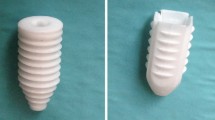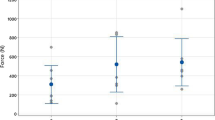Abstract
Purpose
The purpose of this study is to determine whether the RetroScrew tibial fixation system offers a biomechanical advantage over the Delta screw for anterior cruciate ligament (ACL) reconstruction in cadaveric tibias with low bone mineral density (BMD).
Methods
Ten matched pairs of osteoporotic cadaveric tibiae underwent simulated ACL reconstruction using quadrupled hamstring grafts with one of the two tibial fixation constructs. Group 1 was fixed with the Delta screw (DS; 35-mm antegrade biointerference screw), and group 2 was fixed with the RetroScrew system (RSS; 20-mm retrograde and 17-mm antegrade biointerference screws). Each construct was cyclically loaded (50–200 N, 1 Hz, 500 cycles) and subsequently loaded to failure (20 mm/s).
Results
All specimens were osteoporotic without significant segmental (proximal, middle, and distal) BMD differences between groups by quantitative computed tomography (P = n.s.). A trend was noted for more construct failures due to graft slippage in the DS group (n = 3) over the RSS group (n = 1). There were no significant differences in cyclic displacement (P = n.s.), maximum cyclic stiffness (P = n.s.), maximum load at failure (P = n.s.), or pullout stiffness (P = n.s.) between groups.
Conclusions
In an osteoporotic cadaveric model, there was no significant biomechanical advantage of the RetroScrew system versus the Delta screw for tibial fixation in soft tissue graft ACL reconstruction. However, a trend toward lower graft fixation failure to cyclic loading was noted with the RetroScrew system.
Level of evidence
Biomechanical comparative study, Level II.


Similar content being viewed by others
References
Bayar A, Sarikaya S, Keser S, Ozdolap S, Tuncay I, Ege A (2008) Regional bone density changes in anterior cruciate ligament deficient knees: a DEXA study. Knee 15:373–377
Beynnon BD, Amis AA (1998) In vitro testing protocols for the cruciate ligaments and ligament reconstructions. Knee Surg Sports Traumatol Arthrosc 6(Suppl 1):S70–S76
Bohnsack M, Rühmann O, Lück K, Wirth CJ (2002) The influence of age on the outcome of anterior cruciate ligament reconstruction. Z Orthop Ihre Grenzgeb 140:194–198
Brand JC Jr, Pienkowski D, Steenlage E, Hamilton D, Johnson DL, Caborn DN (2000) Interference screw fixation strength of a quadrupled hamstring tendon graft is directly related to bone mineral density and insertion torque. Am J Sports Med 28:705–710
Brown GA, Peña F, Grøntvedt T, Labadie D, Engebretsen L (1996) Fixation strength of interference screw fixation in bovine, young human, and elderly human cadaver knees: influence of insertion torque, tunnel-bone block gap, and interference. Knee Surg Sports Traumatol Arthrosc 3:238–244
Buss DD, Warren RF, Wickiewicz TL, Galinat BJ, Panariello R (1993) Arthroscopically assisted reconstruction of the anterior cruciate ligament with use of autogenous patellar-ligament grafts. Results after twenty-four to forty-two months. J Bone Joint Surg Am 75:1346–1355
Caborn DN, Coen M, Neef R, Hamilton D, Nyland J, Johnson DL (1998) Quadrupled semitendinosus-gracilis autograft fixation in the femoral tunnel: a comparison between a metal and a bioabsorbable interference screw. Arthroscopy 14:241–245
Caborn DN, Nyland J, Selby J, Tetik O (2003) Biomechanical testing of hamstring graft tibial tunnel fixation with bioabsorbable interference screws. Arthroscopy 19:991–996
Chang HC, Nyland J, Nawab A, Burden R, Caborn DN (2005) Biomechanical comparison of the bioabsorbable RetroScrew system, BioScrew XtraLok with stress equalization tensioner, and 35-mm Delta Screws for tibialis anterior graft-tibial tunnel fixation in porcine tibiae. Am J Sports Med 33:1057–1064
Charlick DA, Caborn DN (2000) Technical note: alternative soft-tissue graft preparation technique for cruciate ligament reconstruction. Arthroscopy 16:E20
Ciccotti MG, Lombardo SJ, Nonweiler B, Pink M (1994) Non-operative treatment of ruptures of the anterior cruciate ligament in middle-aged patients. Results after long-term follow-up. J Bone Joint Surg Am 76:1315–1321
Dahm DL, Wulf CA, Dajani KA, Dobbs RE, Levy BA, Stuart MA (2008) Reconstruction of the anterior cruciate ligament in patients over 50 years. J Bone Joint Surg Br 90:1446–1450
Ejerhed L, Kartus J, Nilsén R, Nilsson U, Kullenberg R, Karlsson J (2004) The effect of anterior cruciate ligament surgery on bone mineral in the calcaneus: a prospective study with a 2-year follow-up evaluation. Arthroscopy 20:352–359
Elliott MJ, Kurtz CA (2007) Peripheral versus aperture fixation for anterior cruciate ligament reconstruction. Clin Sports Med 26:683–693
Gordan GS, Genant HK (1985) The aging skeleton. Clin Geriatr Med 1:95–118
Heier KA, Mack DR, Moseley JB, Paine R, Bocell JR (1997) An analysis of anterior cruciate ligament reconstruction in middle-aged patients. Am J Sports Med 25:527–532
Honl M, Carrero V, Hille E, Schneider E, Morlock MM (2002) Bone-patellar tendon-bone grafts for anterior cruciate ligament reconstruction: an in vitro comparison of mechanical behavior under failure tensile loading and cyclic submaximal tensile loading. Am J Sports Med 30:549–557
Howell SM, Gittins ME, Gottlieb JE, Traina SM, Zoellner TM (2001) The relationship between the angle of the tibial tunnel in the coronal plane and loss of flexion and anterior laxity after anterior cruciate ligament reconstruction. Am J Sports Med 29:567–574
Järvinen M, Kannus P (1997) Injury of an extremity as a risk factor for the development of osteoporosis. J Bone Joint Surg Am 79:263–276
Kannus P, Leppälä J, Lehto M, Sievänen H, Heinonen A, Järvinen M (1995) A rotator cuff rupture produces permanent osteoporosis in the affected extremity, but not in those with whom shoulder function has returned to normal. J Bone Miner Res 10:1263–1271
Kannus P, Sievänen H, Järvinen M, Heinonen A, Oja P, Vuori I (1992) A cruciate ligament injury produces considerable, permanent osteoporosis in the affected knee. J Bone Miner Res 7:1429–1434
Khodadadyan-Klostermann C, von Seebach M, Taylor WR, Duda GN, Haas NP (2004) Distribution of bone mineral density with age and gender in the proximal tibia. Clin Biomech 19:370–376
Klein SA, Nyland J, Caborn DN, Kocabey Y, Nawab A (2005) Comparison of volumetric bone mineral density in the tibial region of interest for ACL reconstruction. Surg Radiol Anat 27:372–376
Kocabey Y, Nawab A, Nyland J, Isikan UE, Caborn D (2004) Soft tissue tendon graft fixation in the tibial tunnel with a bioabsorbable screw-EndoPearl combination in tibiae of low bone mineral density: a biomechanical study. Acta Orthop Traumatol Turc 38:282–287
Larson RV (1996) Anterior cruciate ligament reconstruction with hamstring tendons. Oper Tech Orthop 6:138–146. doi:10.1016/S1048-6666(96)80013-9
Lee JJ, Otarodifard K, Jun BJ, McGarry MH, Hatch GF III, Lee TQ (2011) Is supplementary fixation necessary in anterior cruciate ligament reconstructions? Am J Sports Med 39:360–365
Leppälä J, Kannus P, Natri A, Pasanen M, Sievänen H, Vuori I, Järvinen M (1999) Effect of anterior cruciate ligament injury of the knee on bone mineral density of the spine and affected lower extremity: a prospective one-year follow-up study. Calcif Tissue Int 64:357–363
Lui PP, Ho G, Shum WT, Lee YW, Ho PY, Lo WN, Lo CK (2010) Inferior tendon graft to bone tunnel healing at the tibia compared to that at the femur after anterior cruciate ligament reconstruction. J Orthop Sci 15:389–401
Markolf KL, Gorek JF, Kabo JM, Shapiro MS (1990) Direct measurement of resultant forces in the anterior cruciate ligament. An in vitro study performed with a new experimental technique. J Bone Joint Surg Am 72:557–567
Morgan CD, Kalman VR, Grawl DM (1995) Definitive landmarks for reproducible tibial tunnel placement in anterior cruciate ligament reconstruction. Arthroscopy 11:275–288
Morgan CD, Stein DA, Leitman EH, Kalman VR (2002) Anatomic tibial graft fixation using a retrograde bio-interference screw for endoscopic anterior cruciate ligament reconstruction. Arthroscopy 18:E38
Nilsson BE (1966) Post-traumatic osteopenia. A quantitative study of the bone mineral mass in the femur following fracture of the tibia in man using americium-241 as a photon source. Acta Orthop Scand 37(Suppl 91):1–55
Nyland J, Fisher B, Brand E, Krupp R, Caborn DN (2010) Osseous deficits after anterior cruciate ligament injury and reconstruction: a systematic literature review with suggestions to improve osseous homeostasis. Arthroscopy 26:1248–1257
Nyland J, Kocabey Y, Caborn DN (2004) Insertion torque pullout strength relationship of soft tissue tendon graft tibia tunnel fixation with a bioabsorbable interference screw. Arthroscopy 20:379–384
Petersen MM, Olsen C, Lauritzen JB, Lund B, Hede A (1996) Late changes in bone mineral density of the proximal tibia following total or partial medial meniscectomy. A randomized study. J Orthop Res 14:16–21
Rhee PC, Levy BA, Stuart MJ, Thoreson A, An KN, Dahm DL (2011) A biomechanical comparison of the Delta screw and RetroScrew tibial fixation on initial intra-articular graft tension. Knee Surg Sports Traumatol Arthrosc PMID: 21258782
Rittweger J, Maffulli N, Maganaris CN, Narici MV (2005) Reconstruction of the anterior cruciate ligament with a patella-tendon-bone graft may lead to a permanent loss of bone mineral content due to decreased patellar tendon stiffness. Med Hypotheses 64:1166–1169
Safran MR, Greene HS (2006) Avoidance and management of intra-articular complication of anterior cruciate ligament reconstruction. Instr Course Lect 55:475–488
Scheffler SU, Südkamp NP, Gőckenjan A, Hoffmann RF, Weiler A (2002) Biomechanical comparison of hamstring and patellar tendon graft anterior cruciate ligament reconstruction techniques: the impact of fixation level and fixation method under cyclic loading. Arthroscopy 18:304–305
Selby JB, Johnson DL, Hester P, Caborn DN (2001) Effect of screw length on bioabsorbable interference screw fixation in a tibial bone tunnel. Am J Sports Med 29:614–619
Sievänen H, Heinonen A, Kannus P (1996) Adaptation of bone to altered loading environment: a biomechanical approach using X-ray absorptiometric data from the patella of a young woman. Bone 19:55–59
Sievänen H, Kannus P, Heinonen A, Oja P, Vuori I (1994) Bone mineral density and muscle strength of lower extremities after long-term strength training, subsequent knee ligament injury and rehabilitation: a unique 2-year follow-up of a 26-year-old female student. Bone 15:85–90
Simonian PT, Erickson MS, Larson RV, O’Kane JW (2000) Tunnel expansion after hamstring anterior cruciate ligament reconstruction with 1-incision EndoButton femoral fixation. Arthroscopy 16:707–714
Takata S, Abbaspour A, Kashihara M, Nakao S, Yasui N (2007) Unilateral chronic insufficiency of anterior cruciate ligament decreases bone mineral content and lean mass of the injured lower extremity. J Med Invest 54:316–321
Takeuchi R, Saito T, Mituhashi S, Suzuki E, Yamada I, Koshino T (2002) Double-bundle anatomic anterior cruciate ligament reconstruction using bone-hamstring-bone composite graft. Arthroscopy 18:550–555
Walsh MP, Wijdicks CA, Parker JB, Hapa O, LaPrade RF (2009) A comparison between a retrograde interference screw, suture button, and combined fixation on the tibial side in an all-inside anterior cruciate ligament reconstruction: a biomechanical study in a porcine model. Am J Sports Med 37:160–167
Weiler A, Hoffmann RF, Siepe CJ, Kolbeck SF, Südkamp NP (2000) The influence of screw geometry on hamstring tendon interference fit fixation. Am J Sports Med 28:356–359
Weiler A, Richter M, Schmidmaier G, Kandziora F, Südkamp NP (2001) The EndoPearl device increases fixation strength and eliminates construct slippage of hamstring tendon grafts with interference screw fixation. Arthroscopy 17:353–359
Weiss J, Paulos LE (1999) Mechanical testing of ligament fixation devices. Tech Orthop 14:14–21
Wu SY, Jia HH, Hans D, Lan J, Wang LY, Li JX, Cai YZ (2009) Assessment of volumetric bone mineral density of the femoral neck in postmenopausal women with and without vertebral fractures using quantitative multi-slice CT. J Zhejiang Univ Sci B 10:499–504
Yoo JC, Ahn JH, Kim JH, Kim BK, Choi KW, Bae TS, Lee CY (2006) Biomechanical testing of hybrid hamstring graft tibial fixation in anterior cruciate ligament reconstruction. Knee 13:455–459
Zerahn B, Munk AO, Helweg J, Hovgaard C (2006) Bone mineral density in the proximal tibia and calcaneus before and after arthroscopic reconstruction of the anterior cruciate ligament. Arthroscopy 22:265–269
Conflict of interest
The authors declare that they have no conflict of interest.
Author information
Authors and Affiliations
Corresponding author
Rights and permissions
About this article
Cite this article
Rhee, P.C., Dahm, D.L., Stuart, M.J. et al. Delta screw versus RetroScrew tibial fixation for ACL reconstruction. Knee Surg Sports Traumatol Arthrosc 19 (Suppl 1), 94–100 (2011). https://doi.org/10.1007/s00167-011-1543-8
Received:
Accepted:
Published:
Issue Date:
DOI: https://doi.org/10.1007/s00167-011-1543-8




